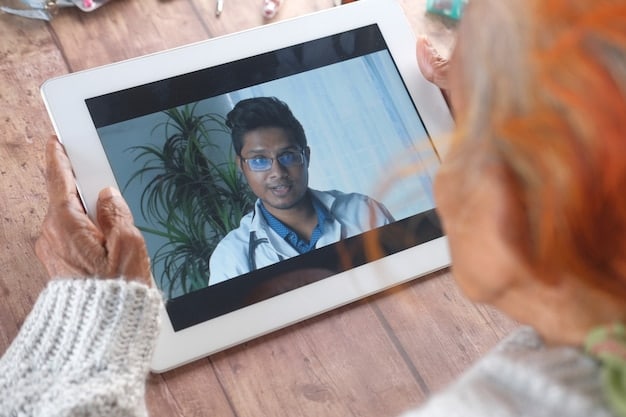The Future of Telemedicine: Transforming Healthcare Access in the US

The future of telemedicine is rapidly evolving, leveraging technology to transform access to medical services by enabling remote consultations, monitoring, and treatment, thereby improving healthcare delivery, especially in underserved areas, and enhancing patient convenience and outcomes.
The landscape of healthcare is undergoing a significant shift, and at the forefront of this transformation is the future of telemedicine. This innovative approach is not just a trend; it’s a fundamental change in how medical services are accessed and delivered, promising greater convenience, efficiency, and reach.
The Rise of Telemedicine: A Technological Revolution
Telemedicine has emerged as a powerful tool, reshaping the healthcare industry through technological advancements. Its growth is fueled by the increasing availability of high-speed internet, the proliferation of smartphones, and the growing demand for convenient and accessible healthcare solutions.
This technological revolution is breaking down geographical barriers, allowing patients in remote areas to connect with specialists and receive timely medical attention. From virtual consultations to remote monitoring, telemedicine is expanding the possibilities of healthcare delivery.
Key Technological Drivers
Several key technologies are driving the growth and evolution of telemedicine. These include:
- Video conferencing platforms that enable real-time consultations between patients and healthcare providers.
- Mobile health (mHealth) apps that allow patients to track their health data, manage medications, and communicate with their care team.
- Remote patient monitoring (RPM) devices that collect vital signs and other health data, providing valuable insights for healthcare providers.
- Artificial intelligence (AI) and machine learning (ML) algorithms that analyze patient data to identify potential health risks and personalize treatment plans.
These technologies are not only improving access to care but also enhancing the quality and efficiency of healthcare delivery.

Telemedicine also enhances preventive care by enabling continuous monitoring and early intervention, providing a comprehensive approach to health management.
Expanding Access to Healthcare: Breaking Down Barriers
One of the most significant impacts of telemedicine is its ability to expand access to healthcare, particularly for underserved populations. By eliminating geographical barriers and reducing the need for travel, telemedicine makes healthcare more accessible to individuals living in rural areas, those with mobility limitations, and those who lack transportation.
This increased accessibility can lead to improved health outcomes and reduced healthcare disparities. Telemedicine can connect patients with specialists who may not be available locally, providing them with the expertise and care they need.
Benefits for Rural Communities
Telemedicine offers numerous benefits for rural communities, including:
- Increased access to specialists and subspecialists.
- Reduced travel time and expenses for patients and their families.
- Improved continuity of care through remote monitoring and follow-up appointments.
- Enhanced access to mental health services, which are often lacking in rural areas.
By addressing these challenges, telemedicine is playing a crucial role in improving the health and well-being of rural communities.
Telemedicine facilitates timely interventions and preventative care, which can prevent serious health crises and reduce hospital admissions.
Remote Patient Monitoring: A Proactive Approach
Remote patient monitoring (RPM) is a key component of telemedicine, enabling healthcare providers to track patients’ health data remotely and intervene proactively when necessary. RPM devices can collect a wide range of vital signs and other health data, including blood pressure, heart rate, blood glucose levels, and sleep patterns.
This continuous monitoring provides valuable insights into patients’ health status, allowing healthcare providers to identify potential problems early and prevent them from escalating into serious health issues. RPM can also empower patients to take a more active role in managing their own health.

The data collected through RPM can be integrated into electronic health records (EHRs), providing healthcare providers with a comprehensive view of patients’ health history and current condition.
Applications in Chronic Disease Management
RPM has proven particularly effective in managing chronic diseases such as:
- Diabetes: Continuous glucose monitoring and remote coaching can help patients maintain healthy blood sugar levels and prevent complications.
- Heart failure: RPM devices can monitor fluid levels, blood pressure, and heart rate, allowing healthcare providers to detect early signs of worsening heart failure.
- Chronic obstructive pulmonary disease (COPD): RPM can track oxygen saturation levels and breathing patterns, enabling healthcare providers to intervene promptly when patients experience breathing difficulties.
By enabling proactive management of chronic diseases, RPM can improve patients’ quality of life and reduce healthcare costs.
Telemedicine also allows for quick adjustments to treatment plans based on real-time data, optimizing health outcomes.
Mental Health Services: Bridging the Gap
Telemedicine is playing an increasingly important role in addressing the growing need for mental health services. Many individuals face barriers to accessing mental healthcare, including geographical limitations, stigma, and cost. Telemedicine can help overcome these barriers by providing remote access to therapists, psychiatrists, and other mental health professionals.
Virtual therapy sessions can be just as effective as in-person sessions, and they offer the added convenience of being accessible from anywhere with an internet connection. Telemedicine can also facilitate medication management and support groups for individuals with mental health conditions.
Benefits of Telepsychiatry
Telepsychiatry, the use of telemedicine for psychiatric care, offers several benefits, including:
- Increased access to psychiatric care for individuals living in rural areas or those with limited mobility.
- Reduced stigma associated with seeking mental health treatment.
- Improved continuity of care through remote monitoring and follow-up appointments.
- Greater convenience and flexibility for patients and providers.
By expanding access to mental healthcare, telemedicine is helping to improve the mental health and well-being of individuals and communities.
Telemedicine offers private, discreet, and convenient access to mental health professionals, improving adherence to treatment and promoting overall mental well-being.
Challenges and Opportunities in Telemedicine
While telemedicine offers numerous benefits, it also faces certain challenges that need to be addressed to ensure its continued growth and success. These challenges include regulatory issues, reimbursement policies, technology limitations, and patient and provider adoption.
However, these challenges also present opportunities for innovation and improvement. By addressing these issues proactively, the healthcare industry can unlock the full potential of telemedicine and transform the way healthcare is delivered.
Addressing the Challenges
Several strategies can be employed to address the challenges facing telemedicine, including:
- Developing clear and consistent regulatory frameworks that govern the practice of telemedicine across state lines.
- Expanding reimbursement policies to cover a wider range of telemedicine services.
- Investing in infrastructure to improve internet access in underserved areas.
- Providing training and support to healthcare providers to help them adopt telemedicine technologies.
By overcoming these challenges, telemedicine can become an integral part of the healthcare system, providing patients with convenient, accessible, and high-quality care.
Telemedicine’s success is also tied to addressing data security and patient privacy concerns, ensuring the confidentiality of patient information.
The Future of Telemedicine: A Glimpse into Tomorrow
The future of telemedicine is bright, with ongoing advancements in technology and increasing adoption by healthcare providers and patients. As technology continues to evolve, telemedicine will become even more integrated into the healthcare system, offering new and innovative ways to deliver care.
In the coming years, we can expect to see greater use of artificial intelligence (AI), virtual reality (VR), and augmented reality (AR) in telemedicine applications. These technologies will enable more immersive and personalized healthcare experiences, improving patient engagement and outcomes.
Emerging Trends
Some of the emerging trends in telemedicine include:
- The use of AI to automate tasks, such as appointment scheduling and data analysis.
- The development of VR and AR applications for pain management and rehabilitation.
- The integration of telemedicine with wearable devices to provide continuous health monitoring.
- The expansion of telemedicine services to include home-based care and hospice care.
These trends indicate that telemedicine is poised to play an even greater role in healthcare in the years to come.
Telemedicine is being adopted in diverse medical specialties such as dermatology, cardiology, and pediatrics, enabling remote assessments and consultations.
| Key Point | Brief Description |
|---|---|
| 🚀 Increased Access | Telemedicine expands healthcare access to remote and underserved populations. |
| 🩺 Remote Monitoring | RPM allows continuous tracking of vital signs, enabling proactive intervention. |
| 🧠 Mental Health Support | Telemedicine offers convenient access to mental health professionals, reducing stigma. |
| 🤖 AI Integration | AI enhances tasks and personalizes care, like automated scheduling and precise diagnoses. |
Frequently Asked Questions about Telemedicine
▼
Telemedicine uses technology to provide healthcare remotely. It works through video calls, apps, and devices that allow doctors to diagnose, monitor, and treat patients without an in-person visit, improving access and convenience.
▼
Telemedicine offers several benefits, including increased access to care, reduced travel time and costs, greater convenience, and improved health outcomes through remote monitoring and timely interventions.
▼
For many conditions, telemedicine is just as effective as in-person care. Studies have shown positive outcomes in chronic disease management, mental health treatment, and post-operative care through remote services.
▼
Telemedicine platforms are designed with security measures to protect patient data, including encryption, secure servers, and compliance with HIPAA regulations. These measures help ensure confidentiality during virtual consultations.
▼
Telemedicine can provide various medical services, including general consultations, specialist referrals, mental health therapy, remote monitoring of chronic conditions, medication management, and even dermatology evaluations through image analysis.
Conclusion
In conclusion, the future of telemedicine is poised to revolutionize healthcare by expanding access, improving convenience, and enhancing the quality of care through technology. Overcoming current challenges and embracing innovation will unlock its full potential, transforming how medical services are delivered and experienced.





